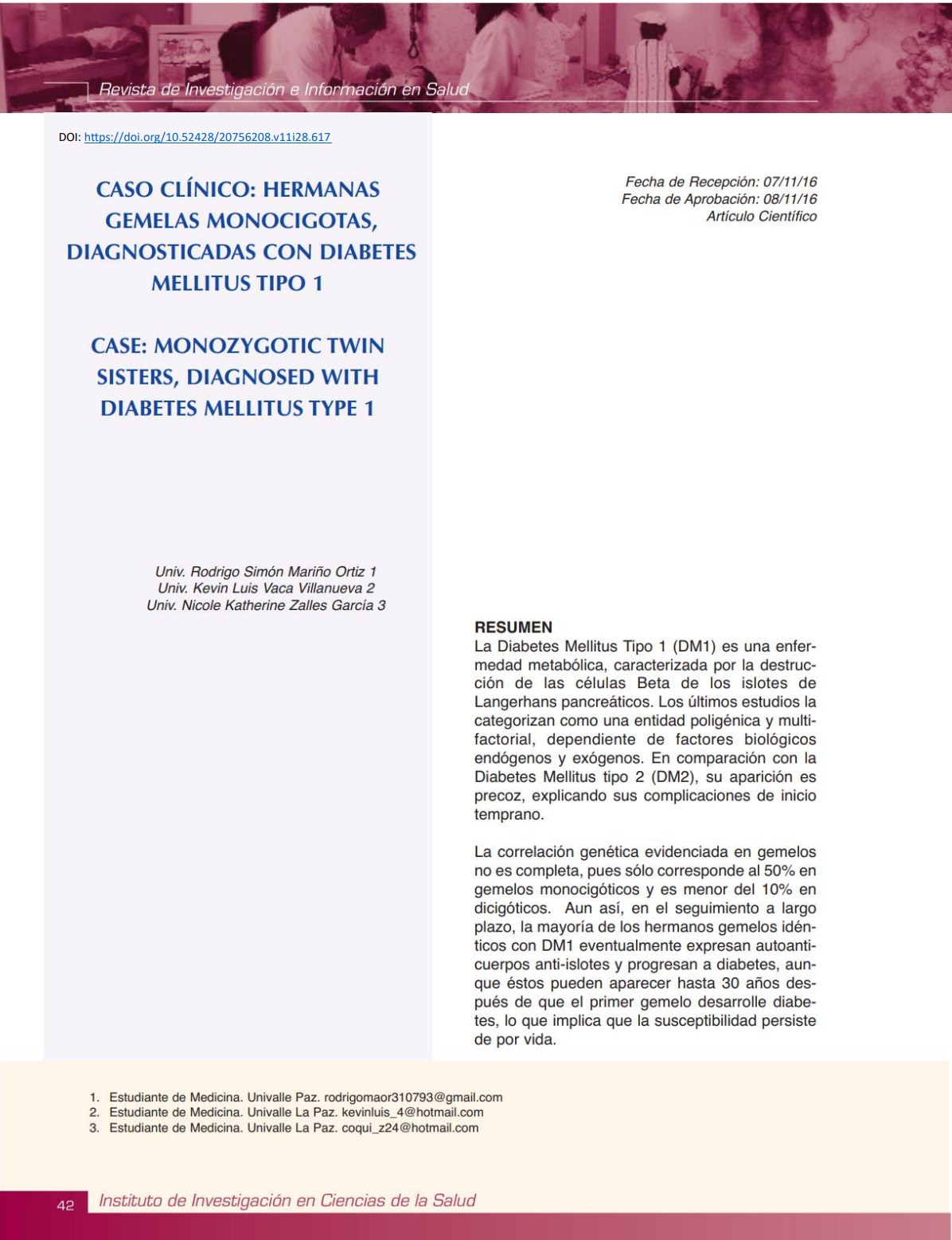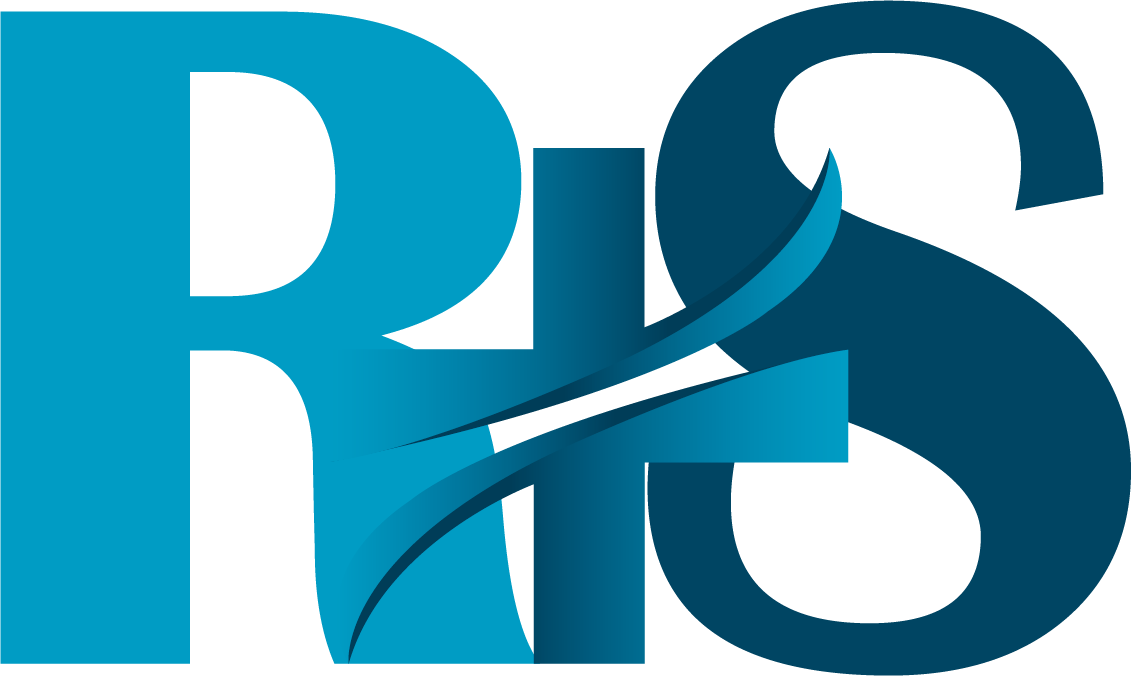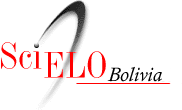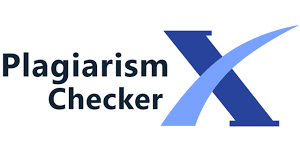Case: Monozygotic Twin Sisters, Diagnosed With Diabetes Mellitus Type 1
DOI:
https://doi.org/10.52428/20756208.v11i28.617Keywords:
Diabetes Mellitus Type 1 (DMI), Monozygous twins, DMI -Genetic FactorAbstract
Type 1 Diabetes Mellitus (DM 1) is a metabolic disease, characterized by the destruction of beta cells of the islets of pancreatic Langerhans. Recent studies categorize it as a polygenic and multifactorial entity, dependent on endogenous and exogenous biological factors. Compared to Type 2 Diabetes Mellitus (DM2), its onset is early, explaining its early onset complications. The genetic correlation observed in twins is not complete, as it only corresponds to 50% in monozygotic twins and is less than 10% in dizygotic twins. Even so, in the long-term follow-up, most identical twin siblings with DM 1 eventually express anti-islet autoantibodies and progress to diabetes, although these can occur up to 30 years after the first twin develops diabetes, implying that susceptibility persists for life. The following is a clinical case, referring to two 25year-old monocitic twin sisters diagnosed with Type I Diabetes Mellitus, where the environmental conditions associated with genetic factors manifested a pathological phenotype, expressed as acyanotic heart disease and nephropathy among others. The importance of clinical analysis in this type of cases is highlighted for the analysis and study of the different pathologies presented in both sisters, with a simultaneous development behavior and similar presentation form.
Downloads
References
1. TOMISLAV M.; Desorden genético (complejo) Mcltrtactortal y Poligérnco. News Medical. 2015
2. TURNPENNY P. Elements of medica! genetics. Edición 14. Phifadelphia. 2012.
3. GuíasALAD sobre diagnóstico, control y tratamiento de la diabetes mellitus tipo 1 con medicina basada en la evidencia 2013. Revista ALAD. 2013 (Acceso en: agosto 2016). Guías ALAD 2013; {Cap. 4 y 5 Prevención y control de la drabetes 28 - 39).
4. MANTEROLA C. Jerarquización de la evidencia: Niveles de evidencia y grados de recomendación de uso actual. (Consulta: agosto de 2016). Disponible en: http://www.scielo.cl/sc1elo.php?scnpt=sc1_arttext&pid=S0716·10182014000600011
5. GÓMEZ A.; Genética. Diabetes Mellitus tipo 1. Versión 1. Colombia: Ed. Endocrino.org. 2015 (Consulta: Agosto, 2016) p.13 14. Disponible en: http://www.endocnno.org.co/wpcontent/uploads/2015/10/Fisiopatologia_de_la_D1abetes_Mellitus_Tipo_1_AM_Gomez.pdf
6. GÓMEZ A.; Pronóstico y conclusiones. Diabetes Methtus tipo 1. Versión 1. Colombia: Ed. Endocrino.org. 2015 (Consulta: Agosto, 2016) p.15 • 16. Disponible en: http://www.enoocnno.org.co/wpcontent/uploads/2015/10/Fisiopatologia_de_la_D1abetes_Mellitus_Tipo_1_AM_Gomez.pdf
7. ESCOBAR F.; Guías clínicas en diabetes mellitus tipo 1 (tablas). Revista de Endocrinología y nutrición. Hospital. Hospital San Cecilia. Universidad de granada. Granada España. Endocnnol Nutr. 2016;56(Supl 4):15•7. Disponible en: http://www.elsev1er.esel23/08/2016/Guíasclínicasendiabetesmellitustipol https://doi.org/10.1016/S1575-0922(09)73510-7
8. IGLESIAS R.; BARUTELL L.; Resumen de las recomendaciones de la American Diabetes Association (ADA) 2014 para la práctica clínica en el manejo de la diabetes mellitus. Diabetes Práctica 2014;05(Supl Extr 2):1•24 (Acceso en: agosto 2016). Disponible en: http://www.diabetespractica.com/suplementos/publicacion.40.html

Downloads
Published
How to Cite
Issue
Section
License
Copyright (c) 2016 Rodrigo Simón Mariño Ortiz , Kevin Luis Vaca Villanueva y Nicole Katherine Zalles Garcia

This work is licensed under a Creative Commons Attribution 4.0 International License.
Authors who publish with this journal agree to the following terms:
- Authors retain copyright and grant the journal right of first publication with the work simultaneously licensed under a Creative Commons Attribution License 4.0 that allows others to share the work with an acknowledgement of the work's authorship and initial publication in this journal.
- Authors are able to enter into separate, additional contractual arrangements for the non-exclusive distribution of the journal's published version of the work (e.g., post it to an institutional repository or publish it in a book), with an acknowledgement of its initial publication in this journal.
- Authors are permitted and encouraged to post their work online (e.g., in institutional repositories or on their website) prior to and during the submission process, as it can lead to productive exchanges, as well as earlier and greater citation of published work.






















